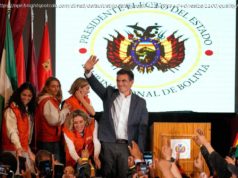May Day has roots as a spring festival in European pagan cultures, but it was dubbed International Workers’ Day by socialist, anarchist and communist groups.
Thousands of labor and immigrant right activists took to the streets Monday for a wave of protests in conjunction with May Day, a day that sparks protests annually among progressives but which took on a sharper edge this year over concerns about President Donald Trump’s agenda.
Across the country, groups urged immigrant workers to skip work, school and shopping to demonstrate their impact on the economy. In Austin, activists staged a sit-in at the governor’s office at the capitol complex to protest a bill increasing immigration enforcement in Texas.
Elsewhere, some of the actions led to arrests. In New York, several protesters were arrested for blocking the entrance to Wells Fargo over the bank’s role financing private Immigration and Customs Enforcement detention centers, according to local news reports. In Oakland, California, four protesters were arrested for trespassing after sneaking past security at the Alameda County government building and unfurling a sign related to sanctuary cities, according to the sheriff’s office.
Live updates from OregonLive.com >>
And late Monday, police in Portland, Oregon, and Seattle braced for the possibility of violence as far-left « anti-fascists » gathered to march, and Trump supporters and far-right activists prepared to counterprotest – a faceoff that has previously erupted in brawls in Berkeley, California, and Seattle.
The demonstrations come as the scope of Trump’s approach to immigration is coming into focus. Immigration arrests rose 33 percent in the first weeks of the Trump administration, including thousands of people who were unlawfully present but otherwise had no criminal record, according to a Washington Post analysis. He has pledged to build a wall that stretches across the U. S.-Mexico border, despite a number of setbacks.
And they come as tensions are rising between far-left and far-right activists. While masked, black-clad activists on the left have been known to vandalize storefronts and damage cars on May Day and during other demonstrations, they have mobilized heavily in the wake of Trump’s election to oppose his supporters, particularly those who espouse racially charged views.
Trump supporters, meanwhile, including members and allies of the loose coalition of far-right activists known as the alt-right, have more recently become engaged in opposing the « antifa » groups. They accuse these groups of trying to block free speech and have sometimes confronted them violently.
In Seattle, Mayor Ed Murray urged calm Monday. Seattle has in the past been the site of violent protests on May Day, as anarchists damage property after dark, when many of the main demonstrations are finished. Far-left and far-right groups have clashed there in recent weeks over planned speeches by conservative provocateurs.
« We celebrate & encourage peaceful #MayDaySea rallies but not violence, » he tweeted Sunday night.
Tensions were high Monday afternoon in Portland, where more than a thousand marchers overflowed downtown Shemanski Park. Protesters waved red cloth flags – some adorned with a yellow hammer and sickle, a communist symbol. From the stage, speakers spoke of ICE raids in local courthouses. Above the crowd waved signs preaching solidarity.
Toward the rear, about 100 black bloc anarchists stood in a huddle with faces and hair covered with black masks. They wheeled in three gigantic black papier-mache spiders, eyes glowing red. All around the park stood police, reporters and legal observers.
But as of Monday evening, the protests nationally were overwhelmingly peaceful.
May Day has roots as a spring festival in European pagan cultures, but it was dubbed International Workers’ Day by socialist, anarchist and communist groups. The moniker commemorates the Haymarket affair, the name given to the violent confrontation that took place in Chicago in 1886 between police and union strikers demanding an eight-hour workday.
It became associated with immigrant workers in the United States in 2006, after weeks of massive protests over a bill that would have cracked down on immigrants in the country illegally. The marches, which took place in the spring and on May 1, are credited with energizing Latino workers and killing the bill, although demonstrators did not achieve their goal of comprehensive immigration reform.






